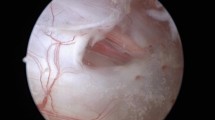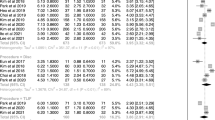Abstract
Background
Spinal percutaneous biportal endoscopic surgery (PBES) is a minimally invasive surgery; however, it is associated with several poor outcomes. This study aimed to analyze unsuccessful PBES outcomes and verify their relationships with patient satisfaction.
Methods
From May 2015 to June 2018, PBES was performed at several institutions. Unsuccessful outcomes (reoperation and prolonged hospital stay) due to various reasons (hematoma, lesion recurrence, incomplete decompression, dural tear, instability, ascites, and infection) were analyzed. To verify the relationships between surgical experience and unsuccessful outcomes, the first 50 cases and the later cases were compared. Logistic regression was used to assess the relationships between unsuccessful outcomes and patient dissatisfaction.
Results
Among 866 patients, 797 cases with 1-year follow-up and complete data were analyzed. In total, 82 patients with unsuccessful outcomes were identified (10.29%). The incidences of hematoma (p < 0.04), incomplete operation (p < 0.01), and dural tear (p < 0.01) were significantly higher in the first 50 cases than in the later cases. Analyses of the relationship between unsuccessful outcomes and patient dissatisfaction showed that incomplete decompression (odds ratio (OR) 4.06), postoperative instability (OR 3.64), hematoma (OR 3.25), ascite (OR 3.25), dural tear (OR 3.02), and local recurrence (OR 2.45, 95%) contributed significantly.
Conclusions
Unsuccessful PBES outcomes were mostly associated with hematomas, incomplete decompression, and dural tears; instability, ascites, and infection contributed to a lesser extent. Incomplete decompression, instability, hematoma, ascite, dural tear, and local recurrence were significantly related to patient dissatisfaction. The potential for poor outcomes should be described to the patient and considered prior to surgery.





Similar content being viewed by others
Abbreviations
- CLA:
-
contralateral approach
- CT:
-
computed tomography
- CSF:
-
cerebrospinal fluid
- FLA:
-
far lateral approach
- IPA:
-
ipsilateral approach
- MRI:
-
magnetic resonance imaging
- ODI:
-
Oswestry Disability Index
- OR:
-
odds ratio
- PBES:
-
percutaneous biportal endoscopic surgery
- POD:
-
postoperative day
- VAS:
-
visual analogue scale
References
Ahn JS, Lee HJ, Park EJ, Kim SB, Choi DJ, Kwon YS, Chung HJ (2019) Multifidus muscle changes after Biportal endoscopic spinal surgery: magnetic resonance imaging evaluation. World Neurosurg. https://doi.org/10.1016/j.wneu.2019.06.148
Ahn Y, Lee HY, Lee SH, Lee JH (2011) Dural tears in percutaneous endoscopic lumbar discectomy. Eur Spine J 20:58–64
Amiri AR, Fouyas IP, Cro S, Casey AT (2013) Postoperative spinal epidural hematoma (SEH): incidence, risk factors, onset, and management. Spine J 13:134–140
Choi KC, Kim JS, Kang BU, Lee CD, Lee SH (2011) Changes in back pain after percutaneous endoscopic lumbar discectomy and annuloplasty for lumbar disc herniation: a prospective study. Pain Med 12:1615–1621
Choi KC, Lee JH, Kim JS, Sabal LA, Lee S, Kim H, Lee SH (2015) Unsuccessful percutaneous endoscopic lumbar discectomy: a single-center experience of 10,228 cases. Neurosurgery 76:372–380
Debnath UK, Freeman BJ, Grevitt MP, Sithole J, Scammell BE, Webb JK (2007) Clinical outcome of symptomatic unilateral stress injuries of the lumbar pars interarticularis. Spine (Phila Pa 1976) 32:995–1000
Eum JH, Heo DH, Son SK, Park CK (2016) Percutaneous biportal endoscopic decompression for lumbar spinal stenosis: a technical note and preliminary clinical results. J Neurosurg Spine 24:602–607
Guerin P, El Fegoun AB, Obeid I, Gille O, Lelong L, Luc S, Bourghli A, Cursolle JC, Pointillart V, Vital JM (2012) Incidental durotomy during spine surgery: incidence, management and complications. A retrospective review. Injury 43:397–401
Heindel P, Tuchman A, Hsieh PC, Pham MH, D'Oro A, Patel NN, Jakoi AM, Hah R, Liu JC, Buser Z, Wang JC (2017) Reoperation rates after single-level lumbar discectomy. Spine. https://doi.org/10.1097/BRS.0000000000001855
Heo DH, Son SK, Eum JH, Park CK (2017) Fully endoscopic lumbar interbody fusion using a percutaneous unilateral biportal endoscopic technique: technical note and preliminary clinical results. Neurosurg Focus. https://doi.org/10.3171/2017.5.FOCUS17146
Hoogland T, Schubert M, Miklitz B, Ramirez A (2006) Transforaminal posterolateral endoscopic discectomy with or without the combination of a low-dose chymopapain: a prospective randomized study in 280 consecutive cases. Spine (Phila PA 1976) https://doi.org/10.1097/01.brs.0000245955.22358.3a
Hoogland T, van den Brekel-Dijkstra K, Schubert M, Miklitz B (2008) Endoscopic transforaminal discectomy for recurrent lumbar disc herniation: a prospective, cohort evaluation of 262 consecutive cases. Spine (Phila Pa 1976) 33:973–978
Ishikura H, Ogihara S, Oka H, Maruyama T, Inanami H, Miyoshi K, Matsudaira K, Chikuda H, Azuma S, Kawamura N, Yamakawa K, Hara N, Oshima Y, Morii J, Saita K, Tanaka S, Yamazaki T (2017) Risk factors for incidental durotomy during posterior open spine surgery for degenerative diseases in adults: a multicenter observational study. PLoS One. https://doi.org/10.1371/journal.pone.0188038
Joswig H, Richter H, Haile SR, Hildebrandt G, Fournier JY (2016) Introducing Interlaminar full-endoscopic lumbar Diskectomy: a critical analysis of complications, recurrence rates, and outcome in view of two spinal Surgeons' learning curves. J Neurol Surg A Cent Eur Neurosurg 77:406–415
Kambin P, Brager MD (1987) Percutaneous posterolateral discectomy. Anatomy and mechanism. Clin Orthop Relat Res 223:145–154
Kang SS, Lee SC, Kim SK (2019) A novel percutaneous Biportal endoscopic technique for symptomatic spinal epidural Lipomatosis: technical note and case presentations. World Neurosurg 129:49–54
Kim CH, Chung CK, Park CS, Choi B, Kim MJ, Park BJ (2013) Reoperation rate after surgery for lumbar herniated intervertebral disc disease: nationwide cohort study. Spine (Phila Pa 1976) 38:581–590
Kim JE, Choi DJ, Kim MC, Park EJ (2019) Risk factors of postoperative spinal epidural hematoma after Biportal endoscopic spinal surgery. World Neurosurg. https://doi.org/10.1016/j.wneu.2019.05.141
Kogias E, Klingler JH, Franco Jimenez P, Vasilikos I, Sircar R, Scholz C, Hubbe U (2017) Incidental Durotomy in open versus tubular revision microdiscectomy: a retrospective controlled study on incidence, management, and outcome. Clin Spine Surg. https://doi.org/10.1097/BSD.0000000000000279
Lawton MT, Porter RW, Heiserman JE, Jacobowitz R, Sonntag VK, Dickman CA (1995) Surgical management of spinal epidural hematoma: relationship between surgical timing and neurological outcome. J Neurosurg 83:1–7
Leven D, Passias PG, Errico TJ, Lafage V, Bianco K, Lee A, Lurie JD, Tosteson TD, Zhao W, Spratt KF, Morgan TS, Gerling MC (2015) Risk factors for reoperation in patients treated surgically for intervertebral disc herniation: a subanalysis of eight-year SPORT data. J Bone Joint Surg Am 97:1316–1325
Lin GX, Huang P, Kotheeranurak V, Park CW, Heo DH, Park CK, Park JY, Kim JS (2019) A systematic review of unilateral Biportal endoscopic spinal surgery: preliminary clinical results and complications. World Neurosurg 125:425–432
Mayer HM, Brock M, Berlien HP, Weber B (1992) Percutaneous endoscopic laser discectomy (PELD). A new surgical technique for non-sequestrated lumbar discs. Acta Neurochir Suppl (Wien) 54:53–58
Moliterno JA, Knopman J, Parikh K, Cohan JN, Huang QD, Aaker GD, Grivoyannis AD, Patel AR, Härtl R, Boockvar JA (2010) Results and risk factors for recurrence following single-level tubular lumbar microdiscectomy. J Neurosurg Spine 12:680–686
Ogihara S, Yamazaki T, Inanami H, Oka H, Maruyama T, Miyoshi K, Takano Y, Chikuda H, Azuma S, Kawamura N, Yamakawa K, Hara N, Oshima Y, Morii J, Okazaki R, Takeshita Y, Tanaka S, Saita K (2018) Risk factors for surgical site infection after lumbar laminectomy and/or discectomy for degenerative diseases in adults: a prospective multicenter surveillance study with registry of 4027 cases. PLoS One. https://doi.org/10.1371/journal.pone.0205539
Park SM, Kim GU, Kim HJ, Choi JH, Chang BS, Lee CK, Yeom JS (2019) Is the use of a unilateral Biportal endoscopic approach associated with rapid recovery after lumbar Decompressive laminectomy? A Preliminary Analysis of a Prospective Randomized Controlled Trial. World Neurosurg. https://doi.org/10.1016/j.wneu.2019.04.240
Ramhmdani S, Xia Y, Xu R, Kosztowski T, Sciubba D, Witham T, Bydon A (2018) Iatrogenic Spondylolisthesis following open lumbar laminectomy: case series and review of the literature. World Neurosurg. https://doi.org/10.1016/j.wneu.2018.02.039
Singh V, Manchikanti L, Benyamin RM, Helm S, Hirsch JA (2009) Percutaneous lumbar laser disc decompression: a systematic review of current evidence. Pain Phys 12:573–588
Wu J, Yu B, He B, Liu G, Ju J, Zhu J (2018) Outcome predictors of the Transforaminal endoscopic spine system technique for single-level lumbar disk herniation. J Neurol Surg A Cent Eur Neurosurg 79:285–290
Zhao XL, Fu ZJ, Xu YG, Zhao XJ, Song WG, Zheng H (2012) Treatment of lumbar intervertebral disc herniation using C-arm fluoroscopy guided target percutaneous laser disc decompression. Photomed Laser Surg 30:92–95
Author information
Authors and Affiliations
Contributions
SKK had full access to all the data in the study and takes responsibility for the integrity of the data and the accuracy of the data analysis. WSK designed the study protocol. SSK and HJP managed the literature searches, summarized previous related work, and wrote the first draft of the manuscript. SHH and SCL provided revision for intellectual content and final approval of the manuscript. All authors read and approved the final manuscript.
Corresponding author
Ethics declarations
Conflict of interest
The authors declare that they have no conflict of interest.
Ethical approval
All procedures performed in studies involving human participants were in accordance with the ethical standards of an appropriate institutional review board (IRB 169684–01–201,906-03) and with the 1964 Helsinki declaration and its later amendments.
Informed consent
For this type of study, formal consent was not required. However, informed consent was obtained from all patients.
Additional information
Publisher’s note
Springer Nature remains neutral with regard to jurisdictional claims in published maps and institutional affiliations.
This article is part of the Topical Collection on Spine degenerative
Electronic supplementary material
ESM 1
(XLSX 116 kb)
Rights and permissions
About this article
Cite this article
Kim, W., Kim, SK., Kang, SS. et al. Pooled analysis of unsuccessful percutaneous biportal endoscopic surgery outcomes from a multi-institutional retrospective cohort of 797 cases. Acta Neurochir 162, 279–287 (2020). https://doi.org/10.1007/s00701-019-04162-2
Received:
Accepted:
Published:
Issue Date:
DOI: https://doi.org/10.1007/s00701-019-04162-2




